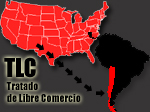On June 6, 2003, Chile and the United States signed a Free Trade Agreement in Miami which will go into effect at the beginning of 2004. The signing came after two years of tough negotiations and some final months of uncertainty as a result of the Iraqi war. Chile, the most open economy of the Southern horn, will finally have access to a market of more than 250 million people with significant purchasing power. Meanwhile, the United States will further advance its strategy – launched 10 years ago by former president George Bush – of deregulating the economies of the continent through the Free Trade Area of the Americas (FTAA).

Sign up to stay informed about our latest article releases.